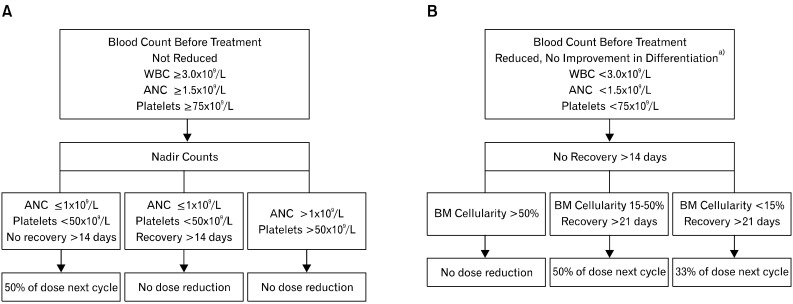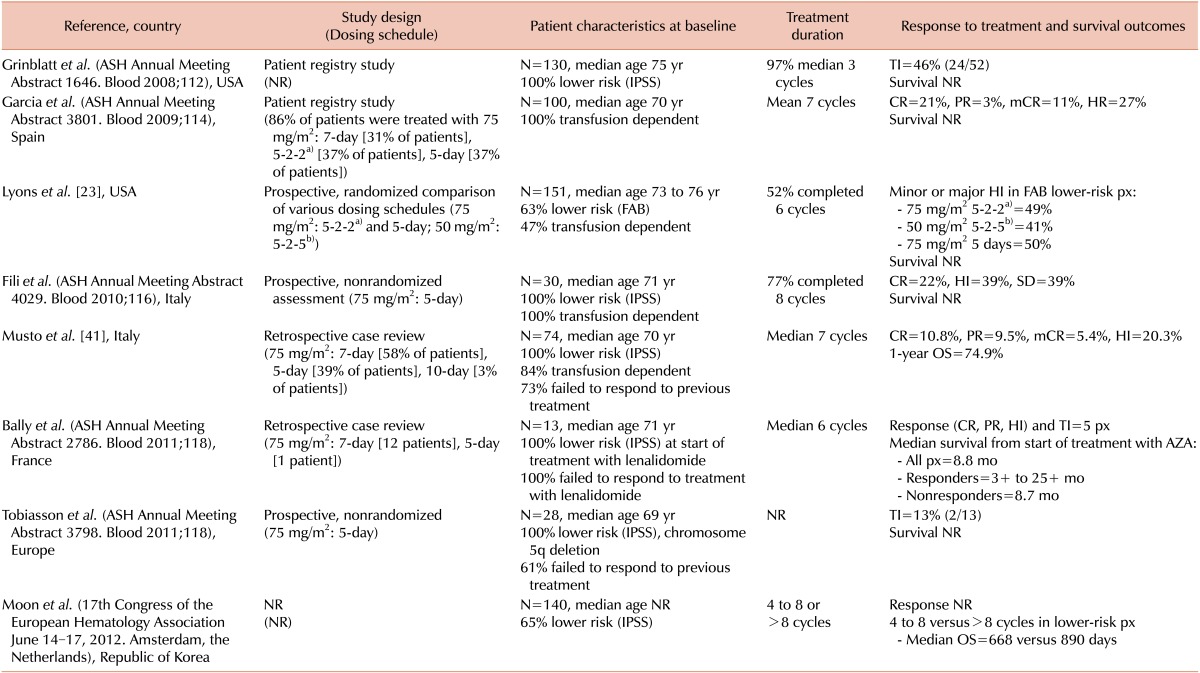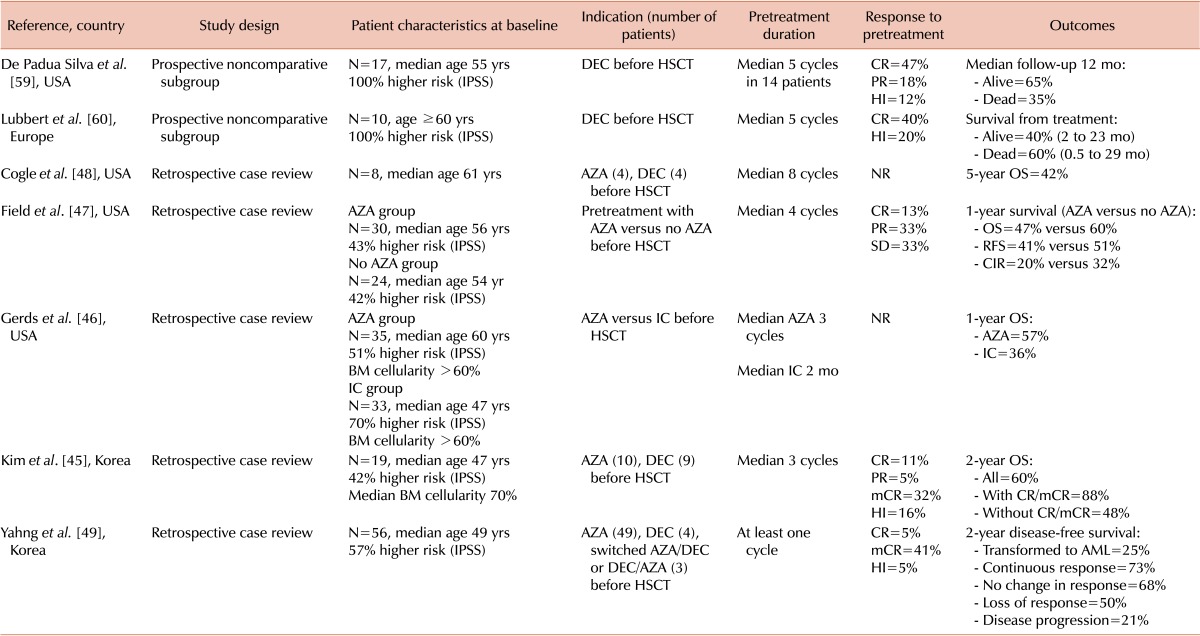2. Greenberg P, Cox C, LeBeau MM, et al. International scoring system for evaluating prognosis in myelodysplastic syndromes. Blood. 1997; 89:2079–2088. PMID:
9058730.

3. Lee JH, Choi Y, Kim SD, et al. Comparison of 7-day azacitidine and 5-day decitabine for treating myelodysplastic syndrome. Ann Hematol. 2013; 92:889–897. PMID:
23420388.

4. Lee YG, Kim I, Yoon SS, et al. Comparative analysis between azacitidine and decitabine for the treatment of myelodysplastic syndromes. Br J Haematol. 2013; 161:339–347. PMID:
23432512.

5. Fenaux P, Mufti GJ, Hellstrom-Lindberg E, et al. Efficacy of azacitidine compared with that of conventional care regimens in the treatment of higher-risk myelodysplastic syndromes: a randomised, open-label, phase III study. Lancet Oncol. 2009; 10:223–232. PMID:
19230772.

6. Silverman LR, Demakos EP, Peterson BL, et al. Randomized controlled trial of azacitidine in patients with the myelodysplastic syndrome: a study of the cancer and leukemia group B. J Clin Oncol. 2002; 20:2429–2440. PMID:
12011120.

7. Fenaux P, Bowen D, Gattermann N, et al. Practical use of azacitidine in higher-risk myelodysplastic syndromes: an expert panel opinion. Leuk Res. 2010; 34:1410–1416. PMID:
20609474.

8. Gotze K, Platzbecker U, Giagounidis A, et al. Azacitidine for treatment of patients with myelodysplastic syndromes (MDS): practical recommendations of the German MDS Study Group. Ann Hematol. 2010; 89:841–850. PMID:
20567826.

9. Matsuda A, Germing U, Jinnai I, et al. Differences in the distribution of subtypes according to the WHO classification 2008 between Japanese and German patients with refractory anemia according to the FAB classification in myelodysplastic syndromes. Leuk Res. 2010; 34:974–980. PMID:
20022110.

10. Toyama K, Ohyashiki K, Yoshida Y, et al. Clinical implications of chromosomal abnormalities in 401 patients with myelodysplastic syndromes: a multicentric study in Japan. Leukemia. 1993; 7:499–508. PMID:
8464227.
11. Wang XQ, Ryder J, Gross SA, Lin G, Irons RD. Prospective analysis of clinical and cytogenetic features of 435 cases of MDS diagnosed using the WHO (2001) classification: a prognostic scoring system for predicting survival in RCMD. Int J Hematol. 2009; 90:361–369. PMID:
19728027.

12. Chen B, Zhao WL, Jin J, et al. Clinical and cytogenetic features of 508 Chinese patients with myelodysplastic syndrome and comparison with those in Western countries. Leukemia. 2005; 19:767–775. PMID:
15759035.

13. Intragumtornchai T, Prayoonwiwat W, Swasdikul D, et al. Myelodysplastic syndromes in Thailand: a retrospective pathologic and clinical analysis of 117 cases. Leuk Res. 1998; 22:453–460. PMID:
9652732.

14. Jung SW, Lee SY, Jekarl DW, et al. Cytogenetic characteristics and prognosis analysis in 231 myelodysplastic syndrome patients from a single institution. Leuk Res. 2011; 35:735–740. PMID:
21146871.

15. Lee JH, Lee JH, Shin YR, et al. Application of different prognostic scoring systems and comparison of the FAB and WHO classifications in Korean patients with myelodysplastic syndrome. Leukemia. 2003; 17:305–313. PMID:
12592327.

16. Lee JJ, Kim HJ, Chung IJ, et al. Comparisons of prognostic scoring systems for myelodysplastic syndromes: a Korean multicenter study. Leuk Res. 1999; 23:425–432. PMID:
10374856.

17. Tran HT, Kim HN, Lee IK, et al. DNA methylation changes following 5-azacitidine treatment in patients with myelodysplastic syndrome. J Korean Med Sci. 2011; 26:207–213. PMID:
21286011.

18. Shen L, Kantarjian H, Guo Y, et al. DNA methylation predicts survival and response to therapy in patients with myelodysplastic syndromes. J Clin Oncol. 2010; 28:605–613. PMID:
20038729.

19. Silverman LR, McKenzie DR, Peterson BL, et al. Further analysis of trials with azacitidine in patients with myelodysplastic syndrome: studies 8421, 8921, and 9221 by the Cancer and Leukemia Group B. J Clin Oncol. 2006; 24:3895–3903. PMID:
16921040.

20. Uchida T, Ogawa Y, Kobayashi Y, et al. Phase I and II study of azacitidine in Japanese patients with myelodysplastic syndromes. Cancer Sci. 2011; 102:1680–1686. PMID:
21624006.

21. Kim DY, Lee JH, Lee JH, et al. Comparison of various criteria in predicting treatment response and prognosis of patients with myelodysplastic syndrome treated with azacitidine. Ann Hematol. 2010; 89:15–23. PMID:
19543727.

22. Moon JH, Kim SN, Kang BW, et al. Predictive value of pretreatment risk group and baseline LDH levels in MDS patients receiving azacitidine treatment. Ann Hematol. 2010; 89:681–689. PMID:
20237926.

23. Lyons RM, Cosgriff TM, Modi SS, et al. Hematologic response to three alternative dosing schedules of azacitidine in patients with myelodysplastic syndromes. J Clin Oncol. 2009; 27:1850–1856. PMID:
19255328.

24. Silverman LR, Fenaux P, Mufti GJ, et al. Continued azacitidine therapy beyond time of first response improves quality of response in patients with higher-risk myelodysplastic syndromes. Cancer. 2011; 117:2697–2702. PMID:
21656747.

25. Santini V, Fenaux P, Mufti GJ, et al. Management and supportive care measures for adverse events in patients with myelodysplastic syndromes treated with azacitidine. Eur J Haematol. 2010; 85:130–138. PMID:
20394651.

26. Lee JH, Lee KH, Lee JH, et al. Decreased incidence of febrile episodes with antibiotic prophylaxis in the treatment of decitabine for myelodysplastic syndrome. Leuk Res. 2011; 35:499–503. PMID:
20674021.

27. Trickett HB, Cumpston A, Craig M. Azacitidine-associated Sweet's syndrome. Am J Health Syst Pharm. 2012; 69:869–871. PMID:
22555082.

28. Tintle S, Patel V, Ruskin A, Halasz C. Azacitidine: a new medication associated with Sweet syndrome. J Am Acad Dermatol. 2011; 64:e77–e79. PMID:
21496689.
29. Kim IH, Youn JH, Shin SH, et al. Neutrophilic panniculitis following azacitidine treatment for myelodysplastic syndromes. Leuk Res. 2012; 36:e146–e148. PMID:
22483068.

30. Smith TJ, Khatcheressian J, Lyman GH, et al. 2006 update of recommendations for the use of white blood cell growth factors: an evidence-based clinical practice guideline. J Clin Oncol. 2006; 24:3187–3205. PMID:
16682719.

31. Garcia-Manero G, Shan J, Faderl S, et al. A prognostic score for patients with lower risk myelodysplastic syndrome. Leukemia. 2008; 22:538–543. PMID:
18079733.

32. Dayyani F, Conley AP, Strom SS, et al. Cause of death in patients with lower-risk myelodysplastic syndrome. Cancer. 2010; 116:2174–2179. PMID:
20162709.

33. Cazzola M, Malcovati L. Myelodysplastic syndromes-coping with ineffective hematopoiesis. N Engl J Med. 2005; 352:536–538. PMID:
15703418.
34. Garcia-Manero G. Myelodysplastic syndromes: 2012 update on diagnosis, risk-stratification, and management. Am J Hematol. 2012; 87:692–701. PMID:
22696212.

35. Park MJ, Kim HJ, Kim SH, et al. Is International Prognostic Scoring System (IPSS) still standard in predicting prognosis in patients with myelodysplastic syndrome? External validation of the WHO Classification-Based Prognostic Scoring System (WPSS) and comparison with IPSS. Eur J Haematol. 2008; 81:364–373. PMID:
18637029.

36. Bejar R, Stevenson KE, Caughey BA, et al. Validation of a prognostic model and the impact of mutations in patients with lower-risk myelodysplastic syndromes. J Clin Oncol. 2012; 30:3376–3382. PMID:
22869879.

37. Greenberg PL, Tuechler H, Schanz J, et al. Revised international prognostic scoring system for myelodysplastic syndromes. Blood. 2012; 120:2454–2465. PMID:
22740453.
38. Malcovati L, Germing U, Kuendgen A, et al. Time-dependent prognostic scoring system for predicting survival and leukemic evolution in myelodysplastic syndromes. J Clin Oncol. 2007; 25:3503–3510. PMID:
17687155.

39. Malcovati L, Della Porta MG, Strupp C, et al. Impact of the degree of anemia on the outcome of patients with myelodysplastic syndrome and its integration into the WHO classification-based Prognostic Scoring System (WPSS). Haematologica. 2011; 96:1433–1440. PMID:
21659359.

40. Cazzola M, Malcovati L. Prognostic classification and risk assessment in myelodysplastic syndromes. Hematol Oncol Clin North Am. 2010; 24:459–468. PMID:
20359637.

41. Musto P, Maurillo L, Spagnoli A, et al. Azacitidine for the treatment of lower risk myelodysplastic syndromes : a retrospective study of 74 patients enrolled in an Italian named patient program. Cancer. 2010; 116:1485–1494. PMID:
20151429.
42. Kantarjian H, O'Brien S, Ravandi F, et al. Proposal for a new risk model in myelodysplastic syndrome that accounts for events not considered in the original International Prognostic Scoring System. Cancer. 2008; 113:1351–1361. PMID:
18618511.

43. Platzbecker U, Schetelig J, Finke J, et al. Allogeneic hematopoietic cell transplantation in patients age 60-70 years with de novo high-risk myelodysplastic syndrome or secondary acute myelogenous leukemia: comparison with patients lacking donors who received azacitidine. Biol Blood Marrow Transplant. 2012; 18:1415–1421. PMID:
22579634.

44. Pollyea DA, Artz AS, Stock W, et al. Outcomes of patients with AML and MDS who relapse or progress after reduced intensity allogeneic hematopoietic cell transplantation. Bone Marrow Transplant. 2007; 40:1027–1032. PMID:
17846595.

45. Kim DY, Lee JH, Park YH, et al. Feasibility of hypomethylating agents followed by allogeneic hematopoietic cell transplantation in patients with myelodysplastic syndrome. Bone Marrow Transplant. 2012; 47:374–379. PMID:
21478916.

46. Gerds AT, Gooley TA, Estey EH, Appelbaum FR, Deeg HJ, Scott BL. Pretransplantation therapy with azacitidine vs induction chemotherapy and posttransplantation outcome in patients with MDS. Biol Blood Marrow Transplant. 2012; 18:1211–1218. PMID:
22252125.

47. Field T, Perkins J, Huang Y, et al. 5-Azacitidine for myelodysplasia before allogeneic hematopoietic cell transplantation. Bone Marrow Transplant. 2010; 45:255–260. PMID:
19543327.

48. Cogle CR, Imanirad I, Wiggins LE, et al. Hypomethylating agent induction therapy followed by hematopoietic cell transplantation is feasible in patients with myelodysplastic syndromes. Clin Adv Hematol Oncol. 2010; 8:40–46. PMID:
20351682.
49. Yahng SA, Yoon JH, Shin SH, et al. Response to pretransplant hypomethylating agents influences the outcome of allogeneic hematopoietic stem cell transplantation in adults with myelodysplastic syndromes. Eur J Haematol. 2013; 90:111–120. PMID:
23113470.

50. Bosi A, Laszlo D, Labopin M, et al. Second allogeneic bone marrow transplantation in acute leukemia: results of a survey by the European Cooperative Group for Blood and Marrow Transplantation. J Clin Oncol. 2001; 19:3675–3684. PMID:
11504749.

51. Platzbecker U, Wermke M, Radke J, et al. Azacitidine for treatment of imminent relapse in MDS or AML patients after allogeneic HSCT: results of the RELAZA trial. Leukemia. 2012; 26:381–389. PMID:
21886171.

52. Jabbour E, Giralt S, Kantarjian H, et al. Low-dose azacitidine after allogeneic stem cell transplantation for acute leukemia. Cancer. 2009; 115:1899–1905. PMID:
19235255.

53. Bolanos-Meade J, Smith BD, Gore SD, et al. 5-azacytidine as salvage treatment in relapsed myeloid tumors after allogeneic bone marrow transplantation. Biol Blood Marrow Transplant. 2011; 17:754–758. PMID:
20951817.
54. Wattel E, De Botton S, Luc Lai J, et al. Long-term follow-up of de novo myelodysplastic syndromes treated with intensive chemotherapy: incidence of long-term survivors and outcome of partial responders. Br J Haematol. 1997; 98:983–991. PMID:
9326199.
55. Kantarjian HM, Giles FJ, Greenberg PL, et al. Phase 2 study of romiplostim in patients with low- or intermediate-risk myelodysplastic syndrome receiving azacitidine therapy. Blood. 2010; 116:3163–3170. PMID:
20631375.

56. Jabbour E, Garcia-Manero G, Batty N, et al. Outcome of patients with myelodysplastic syndrome after failure of decitabine therapy. Cancer. 2010; 116:3830–3834. PMID:
20564137.

57. Prebet T, Gore SD, Esterni B, et al. Outcome of high-risk myelodysplastic syndrome after azacitidine treatment failure. J Clin Oncol. 2011; 29:3322–3327. PMID:
21788559.
58. Shin SH, Yahng SA, Yoon JH, et al. Survival benefits with transplantation in secondary AML evolving from myelodysplastic syndrome with hypomethylating treatment failure. Bone Marrow Transplant. 2013; 48:678–683. PMID:
23128572.

59. De Padua Silva L, de Lima M, Kantarjian H, et al. Feasibility of allo-SCT after hypomethylating therapy with decitabine for myelodysplastic syndrome. Bone Marrow Transplant. 2009; 43:839–843. PMID:
19151791.

60. Lubbert M, Bertz H, Ruter B, et al. Non-intensive treatment with low-dose 5-aza-2'-deoxycytidine (DAC) prior to allogeneic blood SCT of older MDS/AML patients. Bone Marrow Transplant. 2009; 44:585–588. PMID:
19363531.








 PDF
PDF ePub
ePub Citation
Citation Print
Print


 XML Download
XML Download